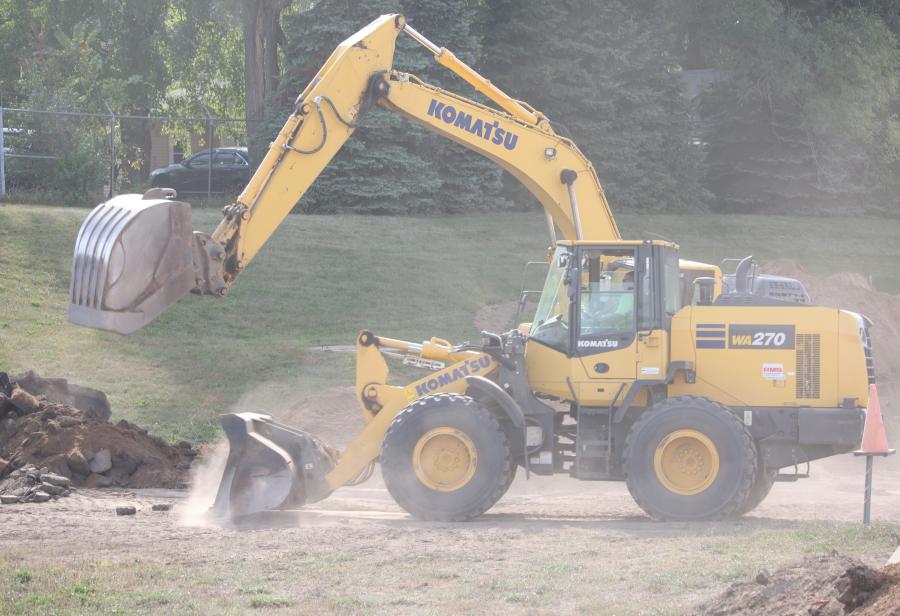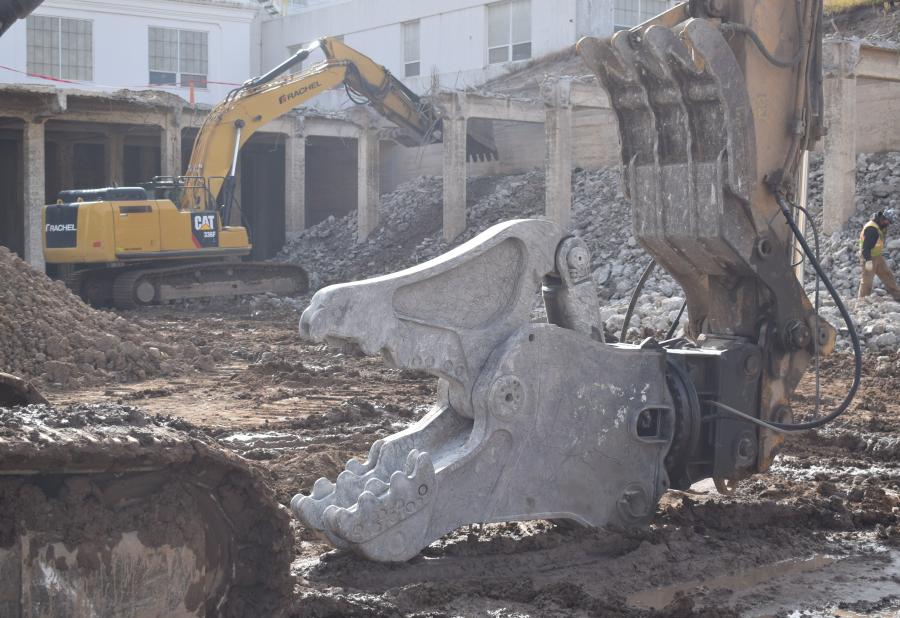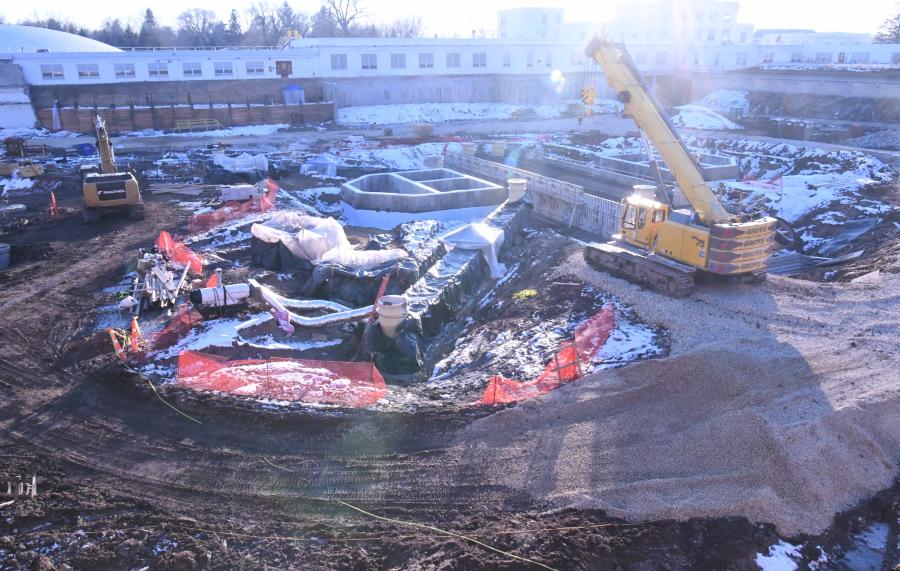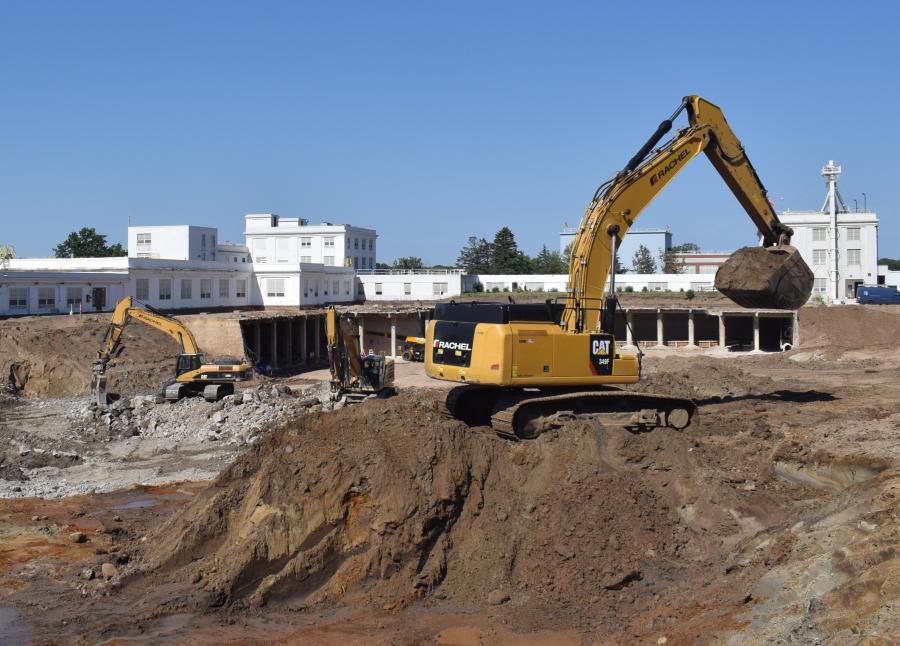Photo courtesy of St. Paul Regional Water Service
Excavation was a dominant piece of the new construction. A total estimate of earthwork on this project is 256,000 cu. yds. of topsoil stripping, excavation, back-fill and cut and fill.
Construction crews are closing in on the final days of the second year of a five-year reconstruction project to improve water treatment facilities and capacity for years to come at the St. Paul Regional Water Service (SPRWS) treatment plant.
Located in the St. Paul, Minn., suburb of Maplewood, the plant is known locally as the McCarron's Water Treatment (MWT) plant. It is a self-supporting public utility funded only by revenue from its customer base. Operating for more than 100 years, the plant serves 450,000 customers in St. Paul and surrounding suburbs.

Photo courtesy of St. Paul Regional Water Service
Through the years, the plant has gone through a variety of improvements and upgrades. This project is notable not only for its upgrades but its cost. At a $250 million price tag, it is the largest capital undertaking in the history of the water treatment plant, according to a SPRWS press release.
The plant also stands out because it earned the President's Award from the Partnership for Safe Water and is the first treatment plant in Minnesota to achieve this honor. It is one of only 31 facilities in the country to be recognized for this award.
To break ground on this project, the SPRWS board of directors secured funding and began assembling a design-build team. Leading the team is Jacobs Engineering to manage the project. Jacobs brought on PCL Construction and Magney Construction for the structural and mechanical elements of the project. Brown and Caldwell, along with Stantec are the owner's advisors as construction moves forward.
Upgrades will replace water purifying equipment, including the clarifiers and recarbonation basins and the addition of ozone equipment to maintain the high quality of the drinking water, as well as prepare for the future treatment of contaminants of emerging concern.
Construction of a new laboratory and office building are part of the construction package. In the event of a massive power failure, on-site power generation will be installed to operate independently of the power grid.
There is a very good reason this is a five-year undertaking. Tons of earthwork, demolition and construction material will go into this upgrade. The project literally has a lot of moving parts and electrical components to it and its design is backed by many of the natural sciences including biochemistry. These functions are all wrapped into a very tight phasing schedule and punctual, on-site management to coordinate contractors and deliveries to keep construction on course.
Once the new water facilities are completed, extensive testing of the water produced by the new plant will begin to ensure its quality and is free of bacteria.
Demolition of the existing water purifying equipment no longer needed will follow once the plant is up and running. Final site work improvements and landscaping will continue into the summer of 2026.
Dozens of sub-contractors will move in and out of the site for the exterior and internal finishing work and the installation of the mechanical, electrical and plumbing systems for the new buildings.
The (MWT) plant can trace its origins to the pioneering days of the late 1860's but it wasn't until 1920 that the construction of the existing plant was completed and began operating.
After treatment, 40 million gal. of water each day — enough to cover a football field in nearly 100 ft. of water — is pumped through 1,100 mi. of water main. This grid is connected to 10,000 water hydrants and 95,000 service lines to serve fresh drinking water to the metro area of St. Paul and its 450,000 residents.
Construction quantities tell part of the story of the intensity of this project. Dominating this list is an estimated 256,000 cu. yds. of earthwork, which includes 7,900 cu. yds. of topsoil stripping; 97,600 cu. yds. of excavation; 124,000 cu. yds. of backfill; and 26,600 cu. yds. of cut and fill.
Going into all the electrical and underground piping components is 7,200 linear ft. of yard pipe and 971,750 linear ft. of wire.

Photo courtesy of St. Paul Regional Water Service
Approximately 20,000 cu. yds. of concrete; 10,000 cu. yds. of CLSM; 1,800 tons of rebar; and 16,500 tons of drainage rock will go into the structural components.
The equipment mobilized for this project includes Cat excavators, dozers, skid loaders and compactors; Volvo and Wacker Neuson compactors; Komatsu excavators and loaders; and a Doosan loader. Lifting equipment includes a Liebherr tower crane and a variety of Grove cranes.
Progress on the work site has been substantial. In under two years of construction, workers have completed more than 40 percent of the project.
"The project is running very smoothly," said Leslie Sjobom, project manager of Jacobs Engineering. "To date, we're about 42 percent complete with the construction phase and are tracking a bit ahead of schedule and on budget. We anticipate beginning to produce water with the new treatment plant in late 2025, after acceptance testing prior to substantial completion."
Will Menkhaus, MWT project manager, attributes the project's success to date to Jacobs Engineering, the design-builder for the new plant, and its team of subcontractors.
"Any project of this size involves coordination with numerous subcontractors," he said. "Jacobs Engineering has done a great job of managing this to keep all contractors aligned and to coordinate activities."
There have been challenges though.
"We encountered unexpectedly high ground water and had to drive a considerable amount of unplanned sheet piling to facilitate the work," Menkhaus said. "This challenge was magnified by the fact that we are working on a small site around infrastructure that may be leaking and contributing to high water tables."
Work began in the spring of 2022 with demolition of one existing clarifier and two, secondary settling basins. Serving another purpose, the space they occupied was essential to provide an adequate work zone to build the new plant.
To accomplish the work to date, workers relied on their Minnesota true grit to build the softening clarifiers, recarbonation and ozonation basins through last years' brutal winter.
"Softening clarifiers involve the construction of precast tanks by DN Tanks. The tanks are nearly complete now and DN Tanks rate of progress has been incredible to watch.
"Recarbonation and ozonation basins are cast in place concrete," said Gary Wilson of Jacobs Engineering. "These basins are mostly complete now and PCL did a really outstanding job of continuing to move the construction forward in spite of an unusually snowy winter in 2022/2023."
Cast-in-place construction of the recarbonation and ozone basins began in the latter half of 2022 and continued throughout the winter months. Pre-casting for the softening clarifiers began in the fall of 2022. They cured over the winter and were erected in the spring of 2023.
"Work on sub-grade preparation began immediately after the demolition was completed," Wilson said. "In addition to standard sub-grade preparation, a ground water drainage system was included on site to hold all ground water below the bottom of the treatment basins. Because so much of the work is sub-grade, earthwork has played a major role on setting the stage for success. Rachel Construction has been handling the earthwork for the project and has done an excellent job of handling the volume and dealing with adverse weather."
Key to the operation of the new plant is the installation of four tanks outfitted with new lime softening clarifiers. Each tank and clarifying equipment have the capacity to produce 28 million gal. of water per day.

Photo courtesy of St. Paul Regional Water Service
The clarifiers are approximately 130 ft. in diameter. Each clarifier will have large rake arms to push solids towards two sludge collection pits. The settled solids and sludge collected in the pits will be pumped out to a separate solids handling facility to be dried. Eventually, these solids will be trucked to the agricultural industry to be used as a pH adjustment and fertilizer on state-wide farmland, Menkhaus said.
New to the treatment process for the new MWT plant is the introduction of ozone into the water to enhance taste, reduce odor, oxidate and disinfect the water. This is accomplished through the construction of three new recarbonation and ozone basins with a capacity to produce 42 million gal. of water per day.
"The recarb-ozone basins will have a plethora of diffuser heads and piping mounted on the floor slab. The CO2 and O3 gas will be bubbled up through the diffuser heads. In the building above the basins, there will be quite a bit of specialized equipment for ozone including an ozone generator and an ozone destruct unit to ensure no ozone leeches out of the basins and into the building above," Menkhaus said.
Going into the new year, "There's a large amount of cast-in-place structural concrete work remaining and that will carry us through the winter season and into spring. With so much of the facility being sub-grade, there will be some large backfill placements in the summer and fall of the upcoming year which will bring us up to finished grade," Menkhaus explained.
The new plant is scheduled to begin operating in late 2025. CEG
Today's top stories























